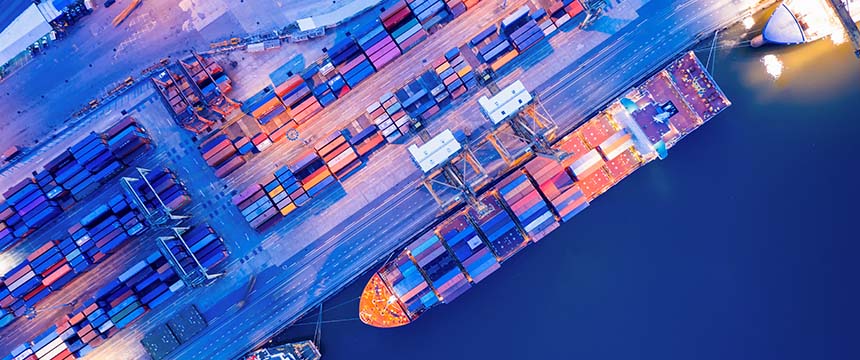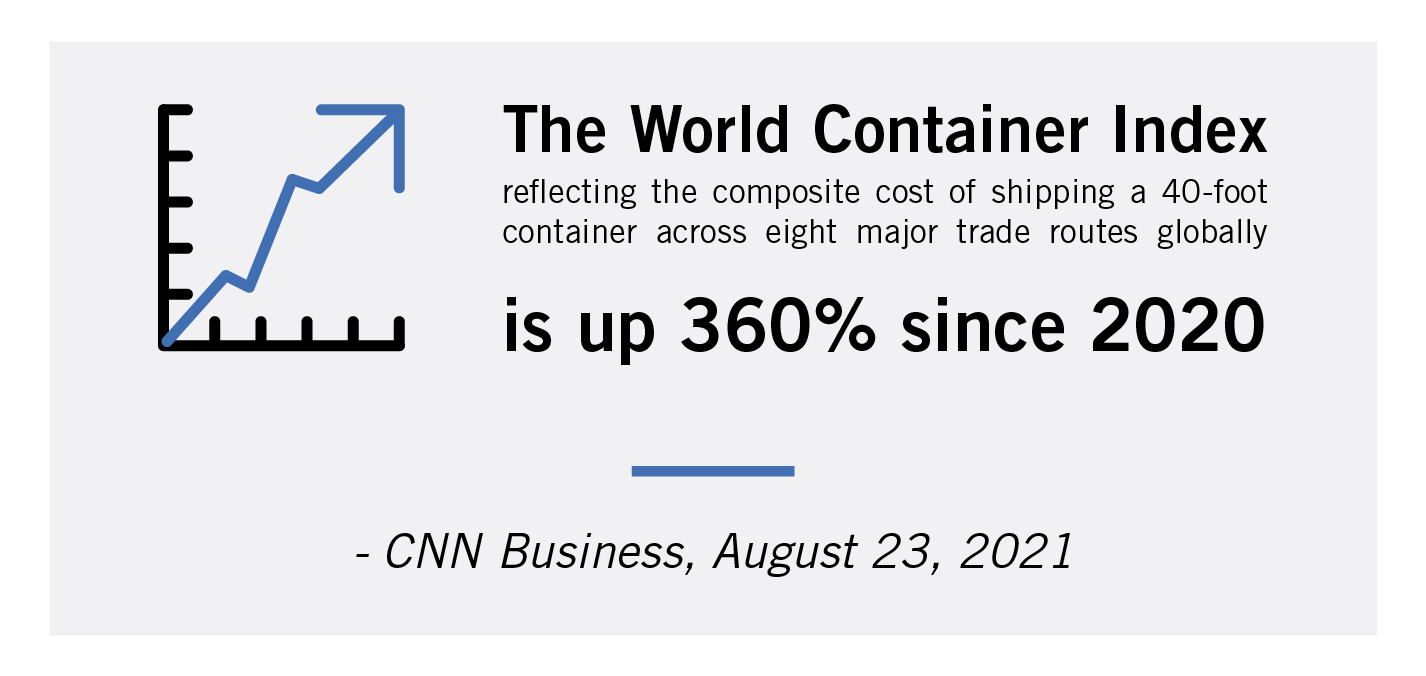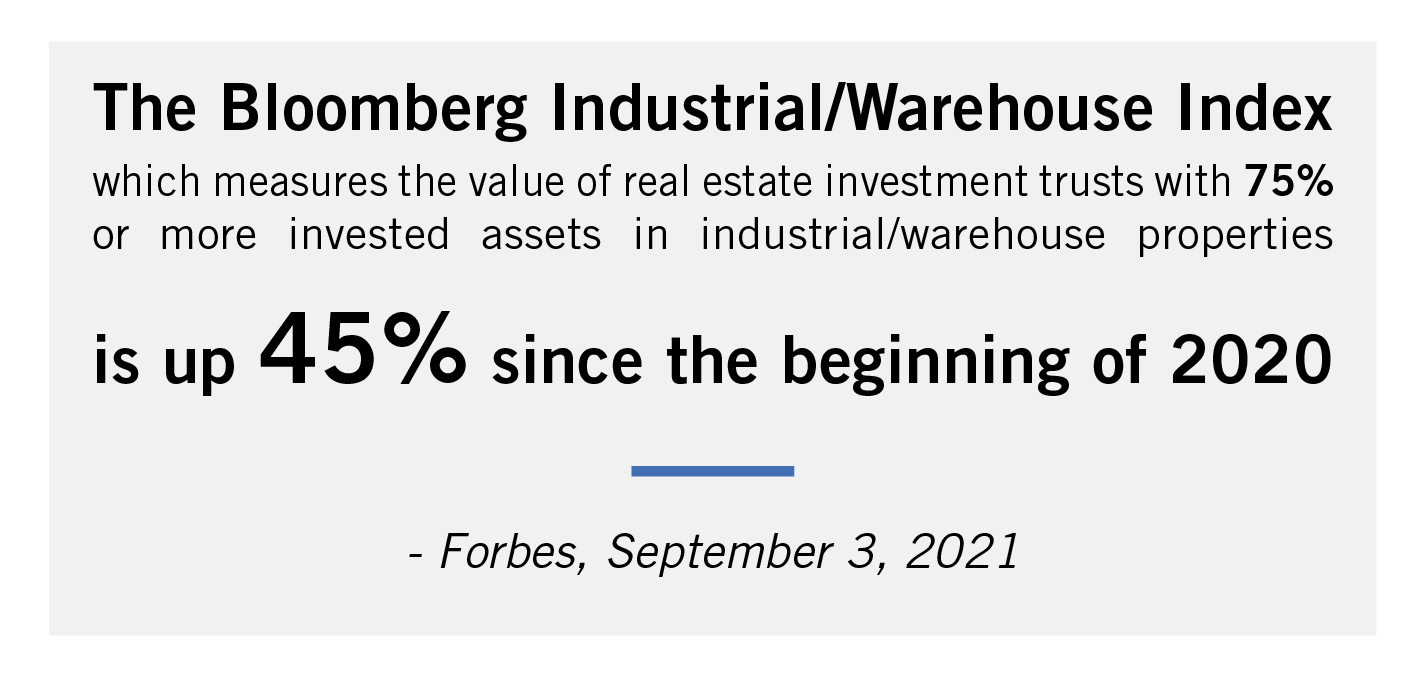
Manufacturers spend a pretty penny managing inventory logistics (the management of inbound and outbound flows of goods) and inventory warehousing (the receipt, storage, and distribution of goods).
In good times, controlling logistics costs presents a challenge. In times of global disruption, the costs can border on unmanageable.1 COVID-19 alone caused huge shortages of consumer products and surges in shipping costs.

In the warehousing sector, a combination of pandemic-driven demand and big-box stores racing to compete with Amazon have caused the cost of warehouse space to skyrocket.3 Companies also face continually increasing warehouse costs due to a rise in construction costs, as well as an increase in investment in sophisticated warehouse robots to automate warehousing.4

Due to the increasing costs involved in managing the flow of inventory, tools to reduce logistics and warehousing costs, such as blockchain technology, are more appealing than ever.
Blockchain Basics for Logistics and Warehousing
Blockchain is a distributed ledger that stores immutable data, shared by participating blockchain network members. A manufacturer can use blockchain to record and view transactions at every step in the supply chain. The distributed ledger format provides companies with a single, unchanging truth to reference for logistics and warehouse planning, management, and dispute resolution.
Companies also benefit from the secure nature of blockchain. Because of blockchain’s immutable and decentralized structure, hackers would find it very difficult to target encrypted information stored on blockchain.
Blockchain Benefits for Logistics
Logistics networks today suffer from complexity and inefficiencies due to lack of visibility and antiquated paper documentation systems. Blockchain remedies these issues.
Lack of Visibility
Because of the complexity of logistics networks, companies often have blind spots in their supply chain, making it difficult to locate products at any given time. Because of this lack of visibility, companies face difficulties in identifying performance lapses. Unavailability of real-time tracking further hinders companies attempting to schedule delivery times and efficiently use company assets.
Blockchain combats inefficiencies by allowing companies to track products in real time and store the related data on a tamper-proof ledger. Blockchain stores information on a shared ledger viewable by all permitted parties, so companies can also reduce administrative processes.
Paper-based Systems
Because logistics networks typically run on paper-based records, each company that touches a product must manually keep records on that product, leading to redundant or potentially inconsistent records. Further, bad actors can easily forge paper documentation. Finally, supply chain members may be slow to deliver and process paper documentation in comparison with digital documentation. In today’s logistics supply chain, containers of product can become stuck at the port while officials wait for the paper bill of lading (which acts as contract of carriage, confirmation of product receipt, and document of title) to arrive.
arrive.
By shifting data and processes to blockchain, companies have access to a system that houses trusted data, which is resistant to cyberattacks and fraudulent manipulation. Blockchain also allows companies to use smart contracts to automate payments and sign documents, which can save time in comparison to traditional manual processes.
With respect to bills of lading, blockchain provides the technology needed to graduate past paper bills of lading and use secure electronic bills of lading (“eB/Ls”) instead. However, a single bill of lading can travel though many countries and change hands through a variety of participants (traders, buyers, carriers, etc.). The complexity inherent in coordinating a manual to digital change in process for a large number of participants hinders widespread adoption of eB/Ls. One challenge is that not all participants may want to engage in the blockchain. Another challenge is that many jurisdictions have not definitively addressed the legal status of electronic transferable records. In order to pave the way to digitize the centuries-old bill of lading format, the United Nations Commission on International Trade Law has published a model law to govern the use of electronic transferable records (such as bills of lading and bills of exchange).7
Blockchain Benefits for Warehousing
As the demand for warehousing increases, the challenges of tracking and managing warehouse inventory have become ever more apparent. Blockchain alleviates the challenges presented in tracking and managing inventory.
Moving Beyond Reactive Inventory Management
Companies usually operate warehouses on a very reactive basis, meaning that companies order more inventory only when stock runs low or predictive models (which can take time to populate) forecast the need to order more inventory.
Blockchain allows companies to track exactly which product is located in the warehouse at a given time. Blockchain technology also allows manufacturers to see end user demand in real time, allowing for better management of manufacturing planning and nimble inventory allocation and replenishment. Warehouses may still rely on a minimum stock volume or predictive models, but blockchain optimizes the determinations more accurately and more timely.
Minimizing Manual Processes
Companies largely operate warehouses using manual processes, including for tracking locations of inventory, picking inventory, and monitoring inventory. While companies continue to phase out manual processes with the advent of warehouse automation advances (such as drones that count inventory and robots that assist laborers with picking), smart warehouses can further increase automation by implementing blockchain. Blockchain increases stocking, replenishing, picking, and packaging efficiencies due to digitization of recordkeeping and use of smart contracts.
Smart Contract Solutions
Blockchain technology allows for implementation of “smart contracts,” which are computer programs that automatically execute an action according to a pre-determined set of rules. This feature can simplify transactions between supply chain members and offer an audit trail for those transactions. Supply chain members can be paid faster and reduce administrative costs. Logistics and warehouse companies can use smart contracts to:
- Automate recordings of delivery times and receipt of goods into inventory.
- Automate payments for inventory received.
- Alert relevant parties if product held in inventory will expire or if the price of product held in inventory has met a strike price.
- Work with IoT devices to trigger alerts if warehouse or shipping container conditions change, such as temperature and humidity.
- Automate payment of credits for failure to meet Service Level Agreement (SLA) and Key Performance Indicator (KPI) metrics.
- Automate recording of product transfers between supply chain members from factory to consumer.
- Execute trade deals automatically by connecting importers, exporters, and their respective banks to the blockchain to reduce duplicative paperwork and redundant quality assurance processes.
See Article 5 of this “Blockchain in Supply Chain” series for more information on smart contracts and the various legal issues to be considered when using them.
Designing Blockchain for Logistics and Warehousing
Blockchain can uniquely address the challenges faced by companies in the logistics and warehousing steps of the supply chain by providing streamlined delivery processes and improved inventory management. However, complexity of supply chains and hesitancy to invest in the blockchain infrastructure could pose barriers to blockchain adoption in the logistics and warehousing spaces.
As a result, leading companies, such as UPS, Penske, and Salesforce, formed the Blockchain in Transport Alliance (“BiTA”) the largest commercial blockchain alliance in the world.8 BiTA has over 500 members in 25 countries,9 including 3PLs/4PLs, logistics companies, air freight companies, railroads, trucking companies, blockchain consulting services, SaaS technology companies, and original equipment manufacturers.10 BiTA aims to drive the adoption of blockchain technology forward and develop a framework and standards for marketplace participants to effectively build blockchain applications.
In another effort to digitize the logistics industry, Maersk and IBM developed the TradeLens platform, designed with blockchain technology to create greater collaboration and trust across the global shipping industry. 11 IBM and Maersk built the TradeLens platform using Hyperledger Fabric blockchain technology and IBM cloud12 to digitally connect shippers, freight forwarders, ports and terminals, customs brokers, and other important members of the global supply chain ecosystem.13
Still, there is no standard blockchain solution for logistics and warehousing, so companies should evaluate whether blockchain would be a cost-effective solution for obtaining a leaner and more efficient supply chain.
————————————————————————————————————————————————
1 Ziady, Hanna, The Shipping Crisis is Getting Worse. Here’s What that Means for Holiday Shopping, CNN Business (August 23, 2021).
2 Id.
3 Levy, Ari, Soaring Warehouse Demand Boost Commercial Real Estate Market as Office Vacancies Mount, CNBC (July 10, 2021).
4 Id.
5 Resource Real Estate Diversified Income Fund, Certified Shareholder Report of Registered Management Investment Companies, United States Securities and Exchange Commission (September 30, 2018).
6 Friesen, Garth, No End in Sight for the COVID-Led Global Supply Chain Disruption, Forbes (September 3, 2021).
7 Clyde & Co LLP, The Legal Status of Electronic Bills of Lading; A Report for the ICC Banking Commission, The International Chamber of Commerce (2018).
8 BiTA Members, BiTA, (last retrieved September 6, 2021); Blockchain in Transport Alliance, BiTA, (last retrieved September 6, 2021).
9 Blockchain in Transport Alliance, BiTA, (last retrieved September 6, 2021).
10 BiTA Members, BiTA, (last retrieved September 6, 2021).


